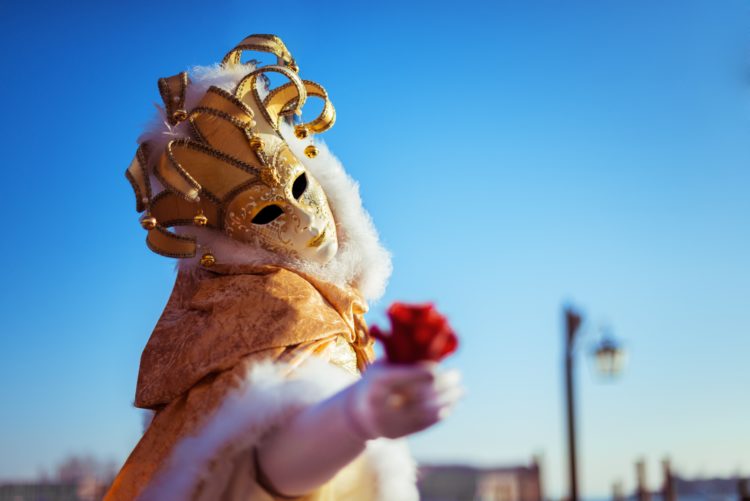Early in the year, in the weeks leading up to Martedì Grasso (Mardi Gras), Venice glitters at its finest. In the mists enveloping lagoons and waterways, costumed revelers drift silently through the crowds, dressed in bright satins and elegant brocades, bowing deeply behind masks. These timeless figures glide through shimmering canals on gondolas to the appreciation of onlookers and tourists throughout the maze of the city.
In honor of this ethereal celebration that marks the traditional start of Lent in the Christian church, add a sparkle to the season by planning a Carnevale-themed gathering of your own. Here’s everything you need to know.
The Origin of Carnevale
The word carnevale (literally “farewell to meat”) references the 40 days of Lent during when Christians refrain from eating meat. However, the roots of the celebration are buried deep in a now-obscure military victory in the 12th century. The Carnevale festival of legend rose to fame in the 1600s, reaching the height of its reputation in the 1700s. But after the Venetian empire fell to Napoleon in 1797, the lavish celebration that had become a synonym for hedonism was outlawed.
Carnevale Today
Carnevale was reinstituted in 1979 to showcase the art and culture of Venice and quickly took hold of the popular imagination.
Festivities
Festivities open in late January with the Festa Veneziana sull’Acqua, when the Rio di Cannaregio transforms into a floating stage with live music, a parade on the water, and shows.
A week later, Volo dell’Angelo (Flight of the Angel) takes place in Piazza San Marco. Dating to the Republic of Venice, it commemorates the bravado of a daring young Turk who scaled the campanile (bell tower) of San Marco, then descended to the piazza on a tightrope, thrilling the crowds. Today, a young Venetian woman descends on cables, high overhead in a fantastic costume. Historically, when the angel lands in the gallery of the Palazzo Ducale, the Doge (Lord) of Venice, greets her with symbolic gifts.
Food
Another sure sign that Carnevale preparations are in full swing is the appearance of the light pastries made of fried dough, called frittelle (frìtole in the Venetian dialect), that fill the shops. Consumed for weeks prior to Martedì Grasso, these inexpensive treats are formed in various shapes, with or without holes in the middle, and are stuffed with creamy temptations like ricotta and zabaglione and dusted with sugar.
Other regions of Italy also offer frittelle, as well as the fried strips of sweet dough dating from Roman times enjoyed everywhere in the country, poetically called cenci (rags) in Tuscany and chiacchiere (chitchat) in Lombardy.
Plan Your Own Carnevale-Themed Gathering
If you’re feeling the Carnevale spirit, host a Martedì Grasso dinner of your own.
Start with ambiance: Evoke Venetian luxe by setting a table rich in tones of green, purple, and red, and opt for candlelight and gilt touches. And since no Italian-themed gathering is complete without the appropriate beverages, stock the bar with bubbly prosecco and red Valpolicella.
On the Menu
Begin with crostini alla baccalà mantecato atop lightly fried squares of firm polenta, and move on to a primo of risotto ai frutti di mare. The piatto secondo (second course) is best characterized by red meat during Carnevale, yet dishes like the lasagna di Carnevale hail from Naples and the South, perhaps an indication of the sweet tooth with which Venetians greet their celebration. For dolce, set out frittelle and cenci with grappa and sgroppino, lemon sorbet whipped with vodka and prosecco, to complete the meal.
Incorporate and welcome the exuberance of the Carnevale di Venezia into your annual calendar — the perfect antidote to the gray months of late winter.
Looking for more ways to bring the charm and elegance of Italy into your home? Find a Santamargherita dealer near you to get started.
—
Monica Sharp is a writer and advocate for the arts who has traveled in more than forty countries. She currently lives in Florence, Italy, with her husband and two young children.

